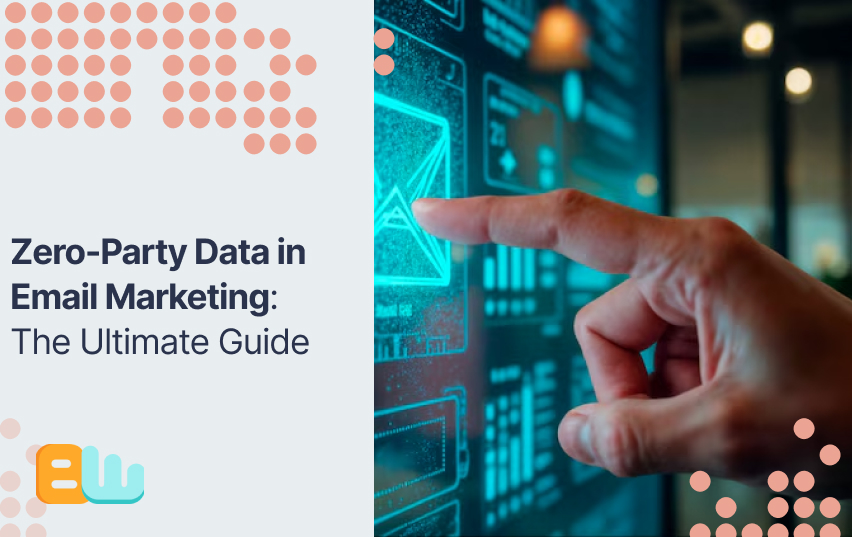
Are you sick of speculating about the interests of your email subscribers? Are you curious about how to make more targeted ads without using third-party cookies? Zero-party data can be exactly what your email marketing plan needs.
Today’s digital environment focuses more on privacy and marketers might face difficulties in customizing content while protecting customer privacy. Zero-party data is an attractive option that is advantageous to both customers and companies.
This article will walk you through the process of gathering, using, and measuring zero-party data in your email marketing campaigns. Let’s get started.
Understanding Zero-Party Data in Modern Marketing
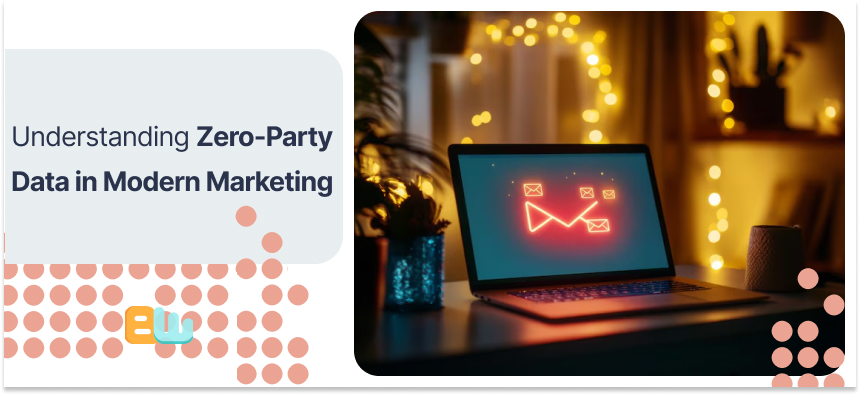
What Is Zero-Party Data and Why It Matters
Information that consumers voluntarily and proactively provide to your brand is known as zero-party data. Zero-party data, as opposed to tracked, observed, or inferred data, is gained directly from consumers who voluntarily provide you with their preferences, intentions, and interests.
Consider it the difference between asking someone what they are buying for today and following them around a store to discover what they are interested in.
Subscribers are giving you zero-party data when they specify their communication choices, particular interests, or the content they would want to receive. Because it builds trust and eliminates uncertainty from your marketing efforts.
How Zero-Party Data Differs from First-Party Data
Although first-party and zero-party data are both privacy-friendly, there are some significant differences between them. Information gathered from website visits, past purchases, email engagement metrics, and other behavioral indicators within your owned channels is known as first-party data.
Zero-party data, by contrast, is explicitly provided by customers. Here’s a simple way to differentiate them:
– First-party data: “I notice you’ve viewed running shoes three times this week.”
– Zero-party data: “I’m training for a marathon and need shoes for long-distance running.”
Because zero-party data offers context and intent that behavioral data alone cannot, this difference is significant. Combining the two forms gives you a more comprehensive understanding of your subscribers’ requirements.
The Rising Importance of Consent-Based Data Collection
Consent-based data gathering is becoming necessary rather than optional as a result of privacy rules such as the CCPA, GDPR, and others that are changing digital marketing. This trend has been further increased by email client privacy restrictions and cookie deprecation.
Sixty-eight percent of consumers are worried about how brands use their data, according to Forrester Research. You may directly solve these issues and increase trust while also obtaining more useful information by putting zero-party data strategies into practice.
5 Key Benefits of Zero-Party Data for Email Campaigns
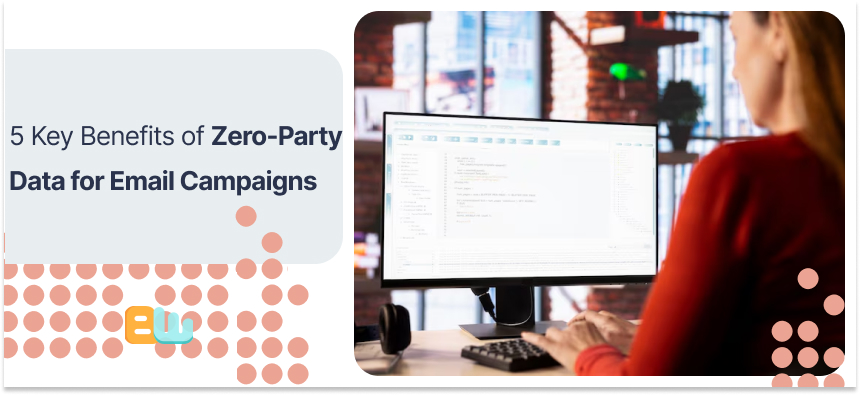
Building Trust Through Transparent Data Collection
When subscribers share information with you, they’re participating in a value exchange that creates trust. They understand what data they’re offering and why, which minimizes the “creepy factor” that sometimes comes with hidden tracking tactics.
This transparency increases your brand reputation. In a Deloitte study, 83% of consumers said they would be more loyal to companies they believe protect their data. By being upfront about how you collect and use information, you represent your brand as respectful and trustworthy.
Always explain why you’re asking for specific information and how it will improve the subscriber’s experience. This explanations makes people more willing to share and creates stronger relationships over time.
Creating Hyper-Personalized Email Experiences That Convert
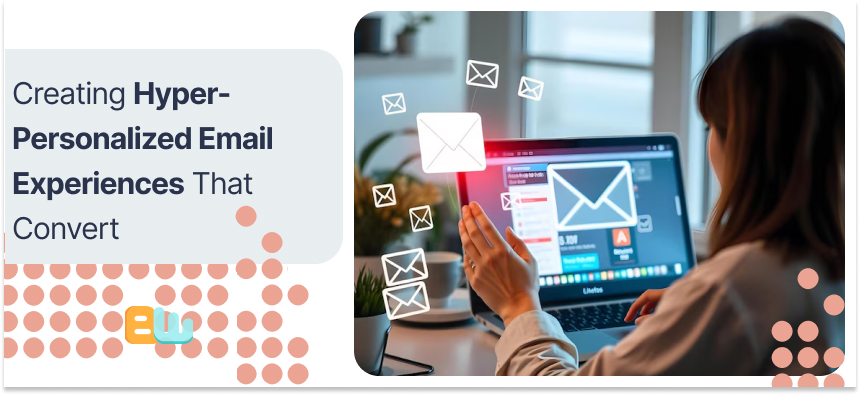
When a subscriber expresses interest in investment, home remodeling, or sustainable fashion, you may customise your material to align with their preferences. All engagement metrics are significantly improved by this degree of relevance.
For instance, clothing retailer “Stitch Fix” gathers zero-party information regarding style preferences, style selections, and budget level through style quizzes and puzzles. Their email campaign is powered by this data, which produces content that is so relevant that their open rates are more than 40% higher than the industry norm.
Improving Email Deliverability with Quality Data
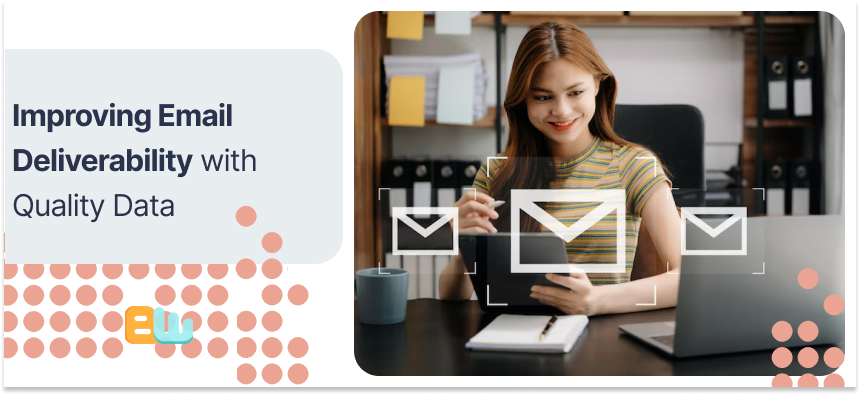
Deliverability is a significant challenge for email marketers. When you send appropriate information based on zero-party data, engagement rates improve—which have a positive influence on deliverability.
Engagement metrics are used by email providers such as Gmail and Outlook to decide whether your messages end up in the spam or inbox. These positive signals guarantee that more of your communications reach their intended recipient when subscribers regularly open, click, and interact with your emails since they are receiving content that they specifically requested.
Reducing Dependency on Third-Party Cookies
Traditional tracking techniques are becoming less trustable due to industry changes, Apple’s privacy changes, and Google’s intention to phase out third-party cookies proves that theory. Zero-party data offers a long-term alternative that is not endangered to these modifications.
You can establish a more reliable data asset by basing your marketing strategy on information that members voluntarily provide. This method increases the caliber of your personalization attempts while protecting your email program against potential privacy modifications.
Enhancing Long-Term Customer Relationships Through Relevance
The impact of zero-party data on client lifetime value is its greatest advantage. Subscribers who receive relevant material are more likely to make more frequent purchases, stay engaged longer, and show greater brand loyalty.
Over time, compounds are impacted by this relevance. Your capacity to provide value grows as you collect more zero-party data and improve your comprehension of subscriber preferences, generating a positive feedback loop that improves bonds and leads to better outcomes.
According to an Epsilon study, 80% of customers are more likely to buy from a brand that provides individualized experiences. This degree of customisation is possible without sacrificing privacy thanks to zero-party data.
7 Effective Strategies to Collect Zero-Party Data
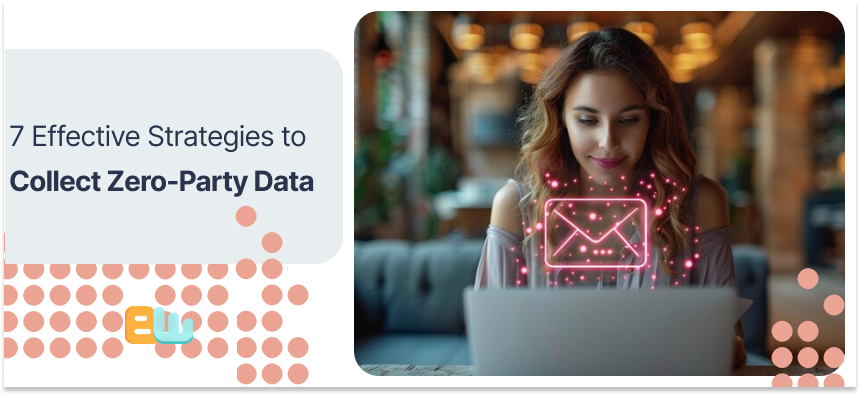
Designing Interactive Email Surveys That Engage Subscribers
Email surveys offer a straightforward approach to gain zero-party data, but their usefulness depends on intelligent design. Keep your email surveys brief—ideally 3-5 questions—and focus on information that will directly improve the subscriber’s experience.
Try utilizing interactive components that make participation simple and interesting, such as rating scales, clickable photos, or preference selectors, instead of traditional multiple-choice formats. Interactive experiences may be created right in the email with the help of tools like AMP for Email or specialist platforms like Typeform.
Additionally, timing is important. When subscribers are most likely to reply, send surveys such as a download or purchase. Always send a thank-you note afterward, explaining how their suggestions will enhance their experience.
Leveraging Preference Centers to Gather Valuable Insights
Preference centers have evolved beyond simple frequency controls into powerful zero-party data collection tools. Modern preference centers allow subscribers to indicate content interests, communication frequency, format preferences, and more.
Make your preference center easily accessible by including a link in every email footer. Periodically remind subscribers they can update their preferences, especially when you notice engagement declining or after significant time has passed since signup.
The most effective preference centers keep options simple while gathering meaningful data. Rather than asking about broad categories, use specific interests that will translate directly into content segmentation. For instance, instead of “Sports,” offer options like “Running,” “Team Sports,” or “Outdoor Activities.”
Using Quizzes and Assessments in Welcome Sequences

Welcome emails are ideal for gathering zero-party data because of their remarkably high open rates. By including tests or quizzes in your welcome sequence, you can take advantage of this first interaction and give new members instant benefits.
Create tests that both gather subscribers’ preferences and help them in finding preferred products, information, or solutions. The “Find Your Shade” questionnaire from the beauty brand Sephora and the “Investment Style” evaluation from the financial service Acorns are great examples of this strategy.
Implementing Progressive Profiling in Email Journeys
Rather than bombarding subscribers with questions up front, progressive profiling distributes data collection over several interactions. This method acknowledges that creating a comprehensive subscriber profile requires time.
During signup, begin by gathering the most important information, and as the connection progresses, ask for more information. Every request should offer a clear benefit in return for the subscriber’s information and be contextually relevant to their journey.
Creating Value Exchange Through Exclusive Content Offers
Exclusive content offers are powerful incentives for zero-party data sharing. When subscribers perceive clear value in exchange for their information, participation rates increase dramatically.
Develop gated content like industry reports, templates, tutorials, or tools that solve specific problems for your audience. Make these resources available in exchange for preference information or survey completion, clearly communicating the value proposition.
Financial technology company NerdWallet effectively uses this approach by offering personalized financial planning guides in exchange for information about financial goals and priorities. The exchange feels fair because subscribers receive immediate value for their input.
Utilizing Post-Purchase Feedback for Better Segmentation
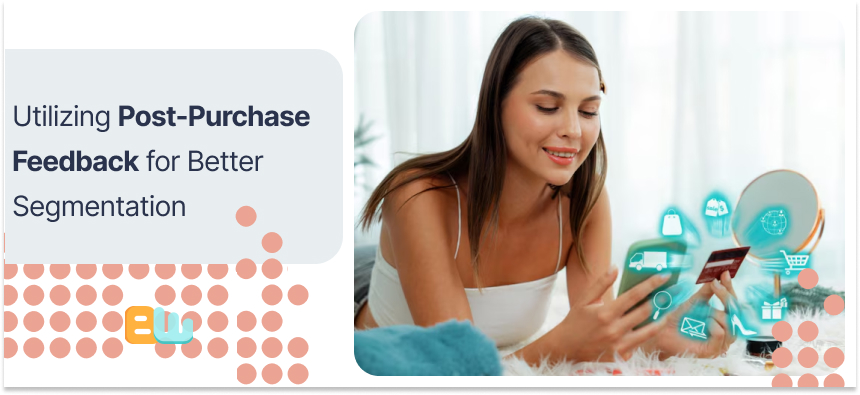
The period immediately after purchase presents a valuable opportunity to collect zero-party data. Customers are engaged with your brand and often willing to provide feedback that can inform future marketing.
Beyond standard product reviews, ask questions about purchase motivation, alternative products considered, or how they plan to use their new purchase. This context helps you understand customer needs more deeply than purchase data alone.
To increase response rates, time these requests carefully (typically 3-7 days after delivery) and keep them focused on aspects that will genuinely improve the customer’s experience with future communications or purchases.
Integrating Social Media and Email for Data Collection
Your social media audience and email list don’t have to exist in separate silos. Create strategic connections between these channels to enhance zero-party data collection.
Use social media polls, questions, and interactive stories to gather preference data, then encourage participants to join your email list for personalized content based on their responses. Conversely, use email to promote interactive social content that collects zero-party data.
How to Implement Zero-Party Data in Email Marketing
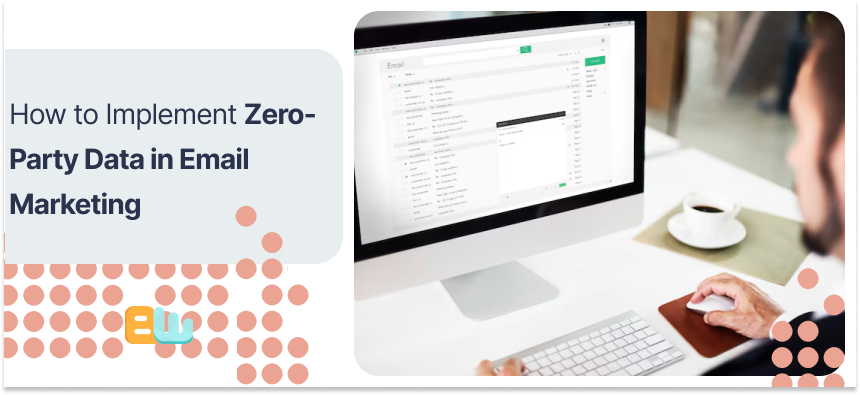
Setting Up Your Email Platform for Data Collection
Make sure your email marketing platform can appropriately gather, store, and activate this data before implementing zero-party data projects. Zero-party data can be stored in custom fields, tags, or attribute functions used in the majority of ESP platforms.
Establish a methodical approach to data organizing by using consistent naming standards and fields with clear labels. Note which team members will have access to the data, how it will be stored, and which data points will be collected.
Think about connecting with specialist customer data platforms (CDPs) that can centralize zero-party data from various sources if your existing platform has limits. Segment, Bloomreach, and ActionIQ are great choices that provide strong data management features.
Segmenting Your Audience Based on Declared Preferences
Effective segmentation transforms zero-party data from interesting information into actionable marketing assets. Start by creating baseline segments based on primary interest categories or buyer personas, then refine with additional declared preferences.
The most powerful segmentation approaches combine zero-party data with behavioral signals. For example, segment subscribers who have declared interest in a specific product category AND recently viewed related products on your website for highly targeted campaigns.
Avoid creating too many narrow segments initially. Begin with broader interest-based groupings, then refine your approach as you gather more data and test different segmentation strategies.
Developing Dynamic Content Based on Subscriber Inputs
Dynamic content blocks allow you to personalize specific sections of your emails based on subscriber data without creating entirely separate campaigns for each segment. This approach scales personalization efficiently.
Map your email templates to identify where dynamic content will have the greatest impact—typically in hero images, product recommendations, content selections, and calls to action. Then create content variations aligned with your most important zero-party data points.
Maintaining Data Quality and Relevance Over Time
Zero-party data can become outdated as subscriber preferences evolve. Implement processes to regularly refresh and validate this information to maintain its value.
Schedule periodic “preference update” campaigns that allow subscribers to confirm or modify their stated interests. Trigger these automatically based on engagement patterns or significant life events that might signal changing needs.
Consider implementing a data sunset policy for certain types of zero-party data. For instance, purchase intentions (“I’m shopping for a new car”) have a shorter shelf life than identity-based preferences (“I’m a vegetarian”), and should be treated accordingly in your marketing automation.
3 Challenges of Zero-Party Data Implementation
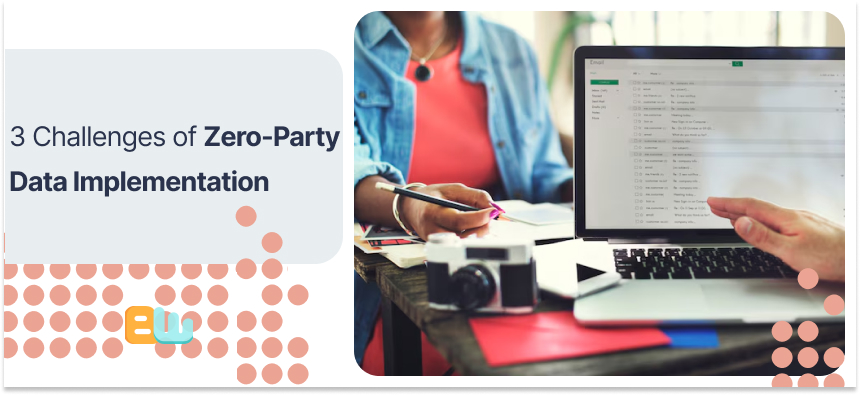
Balancing Data Collection with User Experience
The paradox of zero-party data lies in finding the right balance between gathering comprehensive information and creating frictionless user experiences. Ask too many questions, and you risk abandonment; ask too few, and you limit personalization potential.
Address this challenge by prioritizing the most valuable data points for your specific business objectives. Focus initial collection on information that drives immediate content relevance, then gradually expand your profile through progressive profiling.
Ensuring Compliance with Privacy Regulations Worldwide
Despite zero-party data’s inherent privacy-friendliness, its collection and usage are nevertheless subject to a number of laws, such as the CCPA, GDPR, and other new laws around the world. Compliance is still crucial.
Always give clear explanations of how data will be used, keep consent documents safe, and respect the rights of data subjects, such as requests for access, correction, and deletion. Collaborate with legal advisors to make sure your data gathering strategies satisfy local regulations in each market in which you do business.
Overcoming Technology and Integration Limitations
Many organizations face technical challenges when implementing zero-party data strategies. Legacy systems, disconnected marketing technologies, and data silos can prevent effective activation of collected information.
Before beginning a comprehensive data gathering effort, identify integration requirements by conducting a technology assessment. Make connecting your email platform to other important systems, such as your CRM, e-commerce platform, and customer support tools, which is a top priority.
Measuring Success: Zero-Party Data Impact on ROI
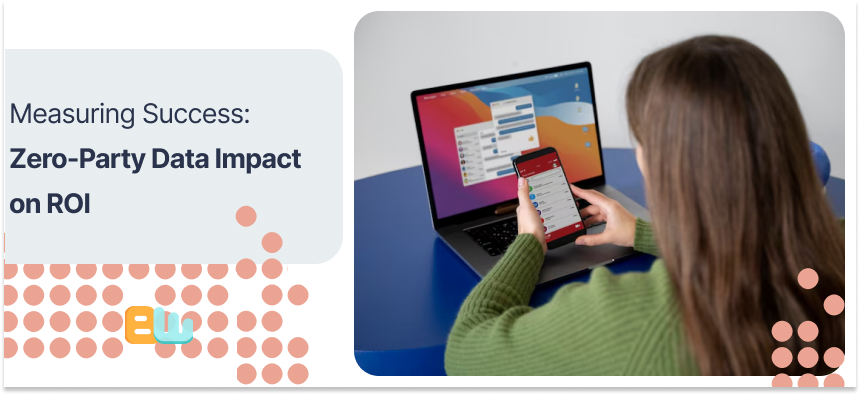
Key Metrics to Track in Zero-Party Data Campaigns
Measuring the impact of zero-party data requires looking beyond standard email metrics to assess both collection effectiveness and downstream performance improvements.
For data collection initiatives, track completion rates, form abandonment points, and the percentage of your audience providing different types of zero-party data. These metrics help optimize the collection process itself.
For email performance, compare standard metrics (open rate, click-through rate, conversion rate) between segments using zero-party data personalization versus control groups receiving standard content. This direct comparison quantifies the personalization value.
Comparing Performance Against Traditional Email Approaches
To demonstrate the value of zero-party data investments, establish controlled tests comparing this approach against your traditional email methods. Create matched audience segments and deliver zero-party data-driven content to one group and conventional content to the other.
Beyond immediate performance metrics, measure longer-term indicators like retention rate, purchase frequency, and customer lifetime value across these segments. The differential impact on these metrics often reveals the most significant benefits of zero-party data.
Document these comparisons methodically to build internal support for expanded zero-party data initiatives. Specific performance improvements provide compelling evidence when requesting additional resources or technology investments.
Calculating the Long-Term Value of Preference Data
The true value of zero-party data extends far beyond immediate campaign performance. Develop models to quantify its long-term business impact through improved customer experiences.
Calculate the reduced acquisition costs resulting from higher retention rates among subscribers receiving preference-based content. Analyze how zero-party data influences average order value and purchase frequency compared to generic segments.
For subscription-based businesses, track churn rate differences between subscribers who have provided zero-party data and those who haven’t. This relationship often reveals how preference-based personalization affects customer loyalty and lifetime value.
Future Trends: Where Zero-Party Data Is Heading

Predictive Analytics and Zero-Party Data Integration
The future of zero-party data lies in its integration with predictive analytics, creating systems that combine explicit preferences with AI-based predictions to anticipate customer needs even more effectively.
Leading brands are already developing hybrid models that use zero-party data as a foundation, then enhance these insights with predictive algorithms that identify probable next interests or actions. This approach maintains privacy while expanding personalization capabilities.
AI-Powered Personalization Using Declared Preferences
By enabling customisation at a scale that was previously unattainable with human segmentation alone, artificial intelligence is revolutionizing the way brands activate zero-party data.
Open-ended survey or feedback form replies can be analyzed by natural language processing (NLP), which can then extract useful preference information from unstructured text. Richer data collecting is made possible by this feature, which eliminates the need for structured questions.
The Evolution of Privacy-First Marketing Strategies
The foundation of privacy-first marketing tactics will be zero-party data as privacy laws continue to spread over the world. In this privacy-focused future, brands who create strong zero-party data assets now will have a big advantage in compare to others.
Instead of gathering data for possible future use, we are witnessing movements toward “data minimalism”—collecting just information with clear, immediate value. This strategy is in line with customer expectations as well as legal constraints.
Conclusion: Building a Zero-Party Data Strategy
Zero-party data represents a fundamental shift in how brands understand and connect with their audiences through email marketing. By prioritizing information freely given rather than tracked or inferred, you create stronger relationships built on mutual value and respect.
Start your zero-party data journey with clear objectives and a focused approach. Identify the most valuable preference data for your specific business, implement thoughtful collection methods, and activate this information through strategic segmentation and dynamic content.
Remember that zero-party data is an ongoing conversation with your audience, not a one-time data collection exercise. As you demonstrate the value of sharing preferences through increasingly relevant content, subscribers will become more willing to provide the information that helps you serve them better.
The brands that will thrive in tomorrow’s privacy-focused landscape are those building zero-party data strategies today. Will yours be one of them?
